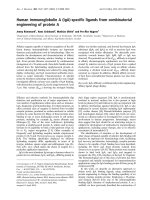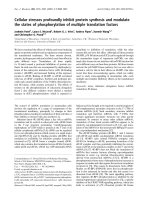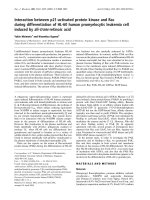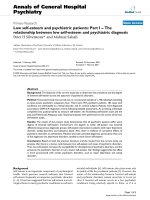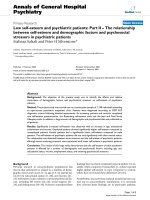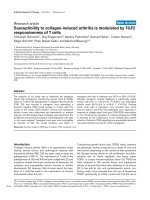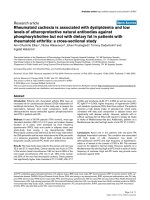Báo cáo y học: " Low tidal volume, high respiratory rate and auto-PEEP: the importance of the basic" ppt
Bạn đang xem bản rút gọn của tài liệu. Xem và tải ngay bản đầy đủ của tài liệu tại đây (35.22 KB, 3 trang )
105
ALI = acute lung injury; ARDS = acute respiratory distress syndrome; PCO
2
= partial carbon dioxide tension; PEEP = positive end-expiratory pres-
sure; Vt = tidal volume.
Available online />“ the wisdom of old men. They do not grow wise.
They grow careful.”
A Farewell to Arms, Ernest Hemingway
The ARDSNet trial [1], which compared a low versus a high
tidal volume (Vt) ventilation strategy, appears to have said the
final word in the controversy surrounding the clinical
relevance of ventilator-induced lung injury. That study indeed
showed that patients with acute respiratory distress
syndrome (ARDS) who were ventilated at 6 ml/kg benefited
from a 22% reduction in mortality, as compared with the
group ventilated with a Vt of 12 ml/kg. As always, and in spite
of these important results, some aspects of the study design
and speculation regarding the mechanisms involved
generated some controversial interpretations [2–5].
Of those, a major interpretation of the ARDSNet findings
pertains to the possible role of auto-PEEP (positive end-
expiratory pressure) in causing the observed difference in
mortality between low and high Vt strategies. The protocol
allowed investigators to increase the respiratory rate in the
low Vt group to 35 breaths/min, in order to minimize
hypercapnia and respiratory acidosis – the major side effects
of low Vt ventilation. A recent study conducted by de Durante
and coworkers [4] demonstrated that the ventilatory settings
employed in the ARDSNet low Vt group may generate an
auto-PEEP of 5.8 ± 3 cmH
2
O. Based upon these data, those
authors suggested that in the ARDSNet study, in spite of
comparable external PEEP settings, total PEEP was
substantially higher in the low Vt group because the high
respiratory rate generated a substantial auto-PEEP. It is
possible to speculate that the observed difference in survival
was more related to the difference in total PEEP than to the
difference in Vt.
Vieillard Baron and coworkers [5] recently investigated the
effects of increasing respiratory rate from 15 to
30 breaths/min, while maintaining a constant plateau
pressure (≤ 25 cmH
2
O). Those authors reported an auto-
PEEP of 6.4 ± 2.7 cmH
2
O at 30 breaths/min, which was
associated with an increased right ventricular outflow
Commentary
Low tidal volume, high respiratory rate and auto-PEEP:
the importance of the basics
Nicolò Patroniti
1
and Antonio Pesenti
2
1
Medical Doctor, Research Fellow, Institute of Anesthesia and Intensive Care Unit, Department of Surgical Science and Intensive Care, Milano-Bicocca
University, Milan, Italy
2
Medical Doctor, Professor of Anesthesia and Intensive Care, Institute of Anesthesia and Intensive Care Unit, Department of Surgical Science and
Intensive Care, Milano-Bicocca University, Milan, Italy
Correspondence: Antonio Pesenti,
Published online: 31 January 2002 Critical Care 2003, 7:105-106 (DOI 10.1186/cc1883)
This article is online at />© 2003 BioMed Central Ltd (Print ISSN 1364-8535; Online ISSN 1466-609X)
Abstract
Recent studies have shown that application of the ARDSNet low tidal volume strategy (i.e. allowing an
increase in respiratory rate in order to minimize hypercapnia in those with low tidal volume) may
generate consistent auto-PEEP (positive end-expiratory pressure), and this is not efficient in improving
clearance of carbon dioxide. The present commentary deals with some of the recent controversies
related to use of a low tidal volume strategy, as implemented in the ARDSNet trial, which has proved
successful in reducing mortality rates in patients with acute respiratory distress syndrome. We
emphasize the importance of basic physiological knowledge and sound respiratory monitoring.
Keywords acute respiratory distress syndrome, auto-PEEP, high respiratory rate, hypercapnia, low-tidal volume strategy
106
Critical Care April 2003 Vol 7 No 2 Patroniti and Pesenti
impedance and a decreased cardiac index. Moreover,
despite the higher respiratory rate, partial carbon dioxide
tension (P
CO
2
) was not significantly different, whereas the
ratio between (alveolar) dead space and Vt increased
significantly. Those authors concluded that, in acute lung
injury (ALI)/ARDS patients, the use of higher respiratory rate
at constant plateau pressure in order to increase minute
ventilation is unable to improve elimination of carbon dioxide,
while it generates auto-PEEP.
What lesson can we derive from those studies? What should
clinicians be careful about? Clearly, there should be no doubt
that a ventilatory strategy based on high Vt and high plateau
pressure should be avoided; years of experimental data
indicate a need for a gentler ventilatory approach. However,
we do not have, and probably will never have, a simple
‘cookbook’ for ventilatory management of patients with
ALI/ARDS. Above all, clinicians should rely on scientific
knowledge, clinical expertise, monitoring and a degree of
wisdom. As stated by Tobin [6], “… there is no substitute for
the clinician’s standing by the ventilator, making necessary
adjustments, and monitoring the effects of such adjustments.
The treatment of patients with the acute respiratory distress
syndrome involves trade-offs in which improvement in one
type of measure … can lead to worsening of another.” If a
single lesson should be picked out from the many
controversies in ventilatory management, then it is that
respiratory mechanics should be monitored.
Does high respiratory rate produce intrinsic PEEP in
ALI/ARDS patients? There should be no doubt as to the
answer to this question. Intrinsic PEEP is a function of minute
ventilation (respiratory rate and Vt), ventilatory setting
(expiratory time) and the mechanical properties of the
respiratory system (flow limitation when present [7], along
with compliance and resistance, taking into account the
ventilator and circuitry). Whenever the expiratory time is too
short to exhale the inspired Vt, given the mechanical
properties of the patient–ventilator complex, auto-PEEP will
occur. Higher compliance and resistance of the respiratory
system, and the possible occurrence of flow limitation will
favour generation of auto-PEEP. These simple principles
concerning auto-PEEP are well established, and anyone
involved in the ventilatory management of any kind of patient
(not just ALI/ARDS patients) should be aware of them and
measure auto-PEEP. Auto-PEEP may easily be assessed by a
simple end-expiratory pause – one of the easiest procedures
on a ventilator. In our opinion, measurement of auto-PEEP
should be part of any monitoring routine.
Should the clinicians bother about auto-PEEP and
associated haemodynamic drawbacks? Of course, the
answer to this question is, again, ‘yes’. However, ventilatory
settings that predispose to auto-PEEP would probably derive
from attempts to control some other variable, such as P
CO
2
.
As always, the final decision is a matter of clinical common
sense and experience in weighing the advantages and the
disadvantages of every option. The haemodynamic effects
associated with auto-PEEP are well known, and the clinician
should be aware of them and monitor them. In the presence
of a known haemodynamic impairment, such as a decreased
cardiac index (as was observed in the study by Vieillard-
Baron and coworkers [5]), the clinician has several choices. If
the priority is to limit ventilator-induced lung injury, and we
persist on a low Vt strategy, then the use of a higher
respiratory rate appears unavoidable if we are to maintain
acceptable P
CO
2
and pH levels. To limit auto-PEEP, we can
try to increase the expiratory time by increasing the
inspiratory flow rate and decreasing the plateau time.
However, a reduction in inspiratory time and in the ratio of
inspiratory to expiratory time may have a negative impact on
oxygenation, which may not be acceptable. On the other
hand, we may tolerate auto-PEEP and try to limit the
haemodynamic impairment associated with auto-PEEP by
directly acting on cardiac function (fluid loads, inotropes), as
we often do to compensate for high levels of external PEEP.
Once again, basic physiology and appropriate monitoring will
lead the clinician to the wisest choice.
Should an increased respiratory rate be used to improve
clearance of carbon dioxide when using a low Vt strategy?
Vieillard-Baron and coworkers [5] stated that increasing the
respiratory rate is not an efficient strategy for improving
carbon dioxide clearance. This is true if a low Vt/high
respiratory rate strategy is compared with a higher Vt/lower
respiratory rate at comparable minute ventilation (physiology
tells us that the dead space : minute ventilation ratio will rise,
decreasing the efficiency of the system). However, the
important issue is not to compare two different strategies of
carbon dioxide clearance, but to recognize that, once we
have selected a low Vt strategy, an increased respiratory rate
is the simplest way to maintain adequate P
CO
2
and pH levels.
In conclusion, in order to survive the numerous discussions
and ideas on how patients with ALI/ARDS should be
managed, the clinician should always count on basic
physiology, which has taught us almost all of the major
principles that we need. Every so often some of these
principles are rediscovered, and this strengthens their role.
After all, it is no bad thing to go back and periodically refresh
our understanding of basic physiology. Appropriate
monitoring will provide us with the necessary information to
appreciate ongoing events and to take the best decision.
Competing interests
None declared.
References
1. The Acute Respiratory Distress Syndrome Network: Ventilation
with lower tidal volumes as compared with traditional tidal
volumes for acute lung injury and the acute respiratory dis-
tress syndrome. N Engl J Med 2000, 342:1301-1308.
107
Available online />2. Eichacker PQ, Gerstenberger EP, Banks SM, Cui X, Natanson C:
Meta-analysis of acute lung injury and acute respiratory dis-
tress syndrome trials testing low tidal volumes. Am J Respir
Crit Care Med 2002, 166:1510-1514.
3. Brower RG, Matthay M, Schoenfeld D: Meta-analysis of acute
lung injury and acute respiratory distress syndrome trials. Am
J Respir Crit Care Med 2002, 166:1515-1516.
4. de Durante G, del Turco M, Rustichini L, Cosinini P, Giunta F,
Hudson LD, Slutsky AS, Ranieri VM: ARDSNet lower tidal
volume ventilatory strategy may generate intrinsic positive
end-expiratory pressure in patients with acute respiratory dis-
tress syndrome. Am J Respir Crit Care Med 2002, 165:1271-
1274.
5. Vieillard-Baron A, Prin S, Augarde R, Desfonds P, Page B,
Beauchet A, Jardin F: Increasing respiratory rate to improve
CO2 clearance during mechanical is not a panacea in acute
respiratory failure. Crit Care Med 2002, 30:1407-1412.
6. Tobin MJ: Culmination of an era in research on the acute res-
piratory distress syndrome. N Engl J Med 2000, 342:1360-
1361.
7. Koutsoukou A, Armaganidis A, Stavrakaki-Kallergi C, Vassi-
lakopoulos T, Lymberis A, Roussos C, Milic-Emili J: Expiratory
flow limitation and intrinsic positive end-expiratory pressure
et zero positive end expiratory pressure in patients with adult
respiratory distress syndrome. Am J Respir Crit Care Med
2000, 161:1590-1596.
